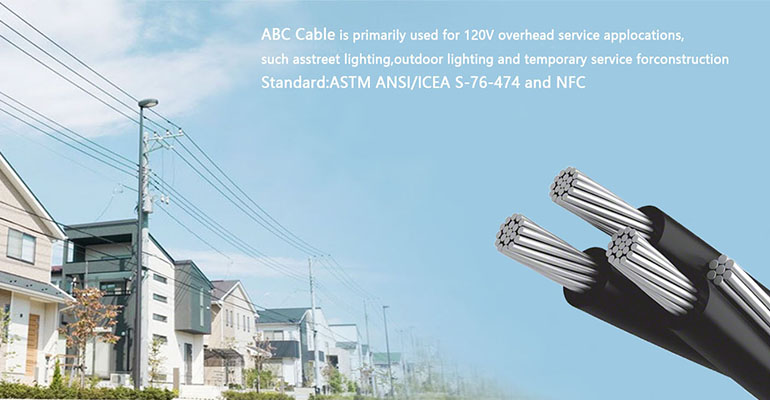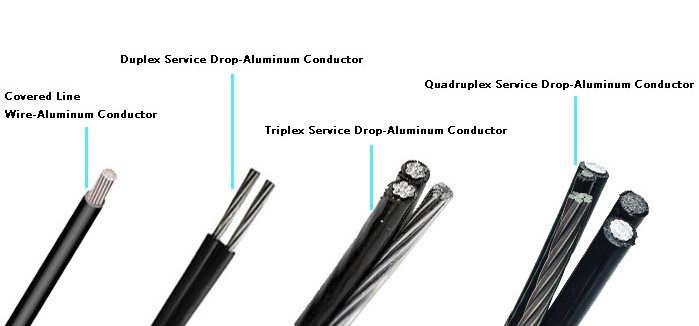- Offices Time:24 Hours Online
- Email:[email protected]
- WhatsApp:+8618339938759

Posted on August 25, 2022
Development and characteristics of Aerial cable
Aerial cable, also known as overhead insulated cable, is an overhead conductor with an insulating layer and a protective sheath. It is manufactured and transmitted using a production process similar to that of cross-linked cables.
Aerial cables are all single-core, and can be divided into hard aluminum wire structure, hard drawn copper wire structure, aluminum alloy wire structure, steel core or aluminum alloy core support structure and self-supporting three-core structure according to their different structures. It has the main characteristics of high power supply reliability, good power supply safety, convenient erection and maintenance, and reasonable economy. Its main technical parameters include weather resistance, insulation level, inner and outer semi-conductive shielding layers. Aerial cables are widely used in power transmission at home and abroad.
1.Development status of overhead cables
Most of the traditional high-voltage power transmission methods use high-voltage overhead lines or high-voltage cable lines as transmission channels, and their respective advantages and disadvantages and their scope of application are determined. Therefore, a new high-voltage transmission method between overhead wires and underground cables – overhead cables has emerged. According to national conditions, many countries took the lead in researching and developing overhead cables in the early 1960s, and overhead cables are widely used in Europe, the United States, Japan and Southeast Asia. Aerial cables are mostly used in the renovation of old power grids in cities. Aerial cables are also widely used in major cities and tourist spots, so various cable manufacturers have also appeared and researched and developed these new popular products.
2.Classification of overhead cables
Aerial cables are made with a special cable similar to the production process of cross-linked cables. General overhead cables are single-core, which can be divided into hard aluminum wire structure, hard-drawn copper wire structure, aluminum alloy wire structure, steel core or aluminum alloy core support structure and self-supporting three-core textured structure according to their different structures Wait.
The duralumin wire structure is light in weight, moderate in tension, easy to bend, easy to install, and low in project cost, so it can be installed on existing towers for use.
The structure of hard-drawn copper wire is heavier, but the pulling force is large, and the ability to resist external force is strong, and the cable can continue to be energized even when the tower is broken. The aluminum alloy wire structure is light in weight and large in tension, and is mainly used in a large-span tower system with a span of 100m.
The steel core or aluminum alloy core support structure is generally used for 35kV voltage system, and the span is also large. The support line and the three insulated phase lines are separated by square insulating parts. The support line can be used as a lightning protection line. The biggest advantage is the arc sag. Small, the arc weight is only about 2.4% of the span.
The self-supporting three-core stranded structure is used in systems with medium spans. The disadvantage of this cable is that the manufacturing length of the three-core cable is shorter than that of the single core, the joints are more, and there is an outer semi-conductive shielding layer. Install terminations or stress cones like ordinary cables.

3.Main properties of overhead cables
(1) High reliability of power supply
The use of overhead cables can greatly reduce all kinds of short-circuit faults. Compared with overhead bare wires, the failure rate is 4-6 times lower. Aerial cables will not produce water trees during use, and the insulation quality of the cables will not decrease significantly after years of operation.
(2) Good power supply security
The use of overhead cables greatly reduces personal electric shock casualties. Through the continuous advancement of research technology, when the overhead cable is energized, when the human body or other animals accidentally touch the cable insulation surface, as long as the cable is not broken down, it will not cause harm to humans and animals.
(3) Ease of erection and maintenance
Aerial cables can be erected on any kind of poles and towers, and can also be erected along walls. In special cases, they can also pass through trees and be directly fixed on tree poles with hardware. In the installation, it can be erected on the original overhead line, using the original cross arm and porcelain bottle, or a full set of matching hardware and accessories. There is no need for special inspection and inspection of overhead cables, and there is no short-circuit trip accident caused by branch flashover, residents throwing debris, or accidental collision of crane arms, which greatly reduces the maintenance and repair work of the line.
(4) Economically reasonable
Using overhead cables is less expensive than ordinary underground installation cables. The most important thing is to reduce the cost of line failure and the direct or indirect loss caused by it. Therefore, its comprehensive cost is obviously lower, more economical and more reasonable.
Post categories
Most Popular Posts
-
The 136th Canton Fair welcomes you to participate!
October 12, 2024 -
High temperature cable introduction
July 26, 2024 -
Kenya Power and Energy Exhibition 2024
June 11, 2024 -
Introduction of rubber sheathed cable
June 5, 2024





